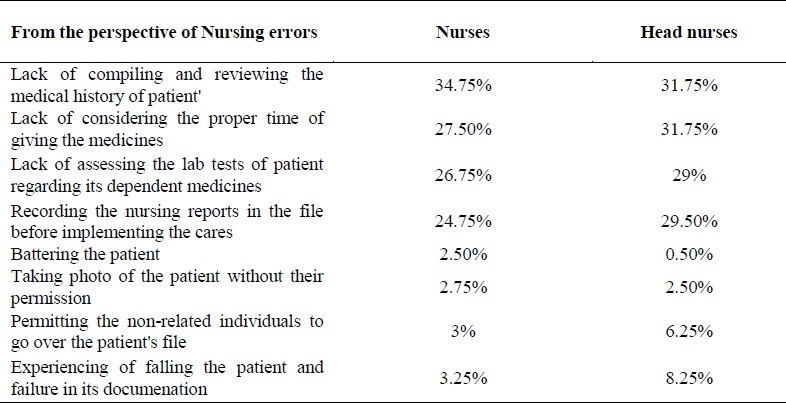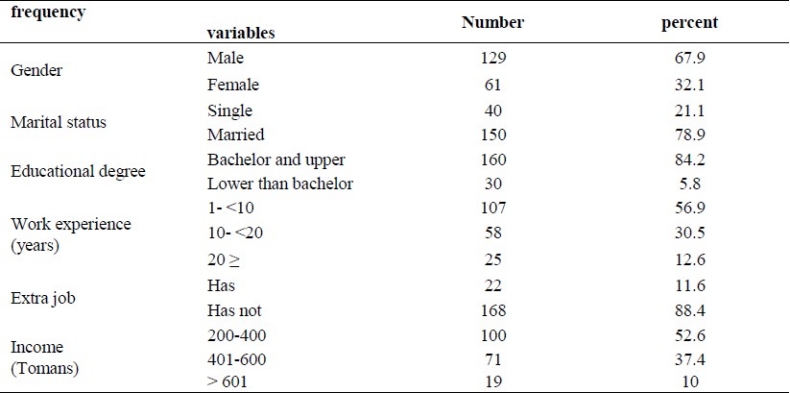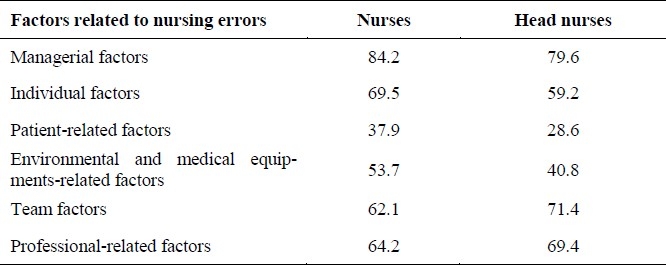Abstract
BACKGROUND:
Error is an inevitable aspect of all the professions particularly health and treatment-related jobs and it should be acknowledged that committing it cannot absolutely be preventable. Among the causes that necessitate the evaluation of nursing errors, it should be noted that errors not only lead to damage and mortality for the patients, but also they are one of the obvious and costly problems in the hospitals. It is believed that nurses have the focal role in committing nursing errors.The main objective of this study was to identify nursing errors and the related factors.
METHODS:
This was a descriptive-correlative study which was conducted in 2010. 239 nurses and head nurses who were working in the selected hospitals in Isfahan were selected randomly and participated in this research. In order to collect the data, two questionnaires were used, each one consisting of three sections of the demographic data, questions about the type of error and the effective factors for making the errors.
RESULTS:
The highest rate of error was reported about the lack of compiling and reviewing the medical history of the patient (31.75%) and also disregarding the appropriate time for prescription of the medicine (31.75%). Besides, the nurses and head nurses believed in more than one factor for committing the errors and mentioned the managerial factors (84.2%) and patient-related factors (50.5%) as the most important and the least important causes for the commitment of errors respectively. Moreover, there was a direct relationship between gender, ward, and having an extra job with the score of the nursing errors.
CONCLUSIONS:
Attempts for reducing and controlling the nursing errors can rely on the usage of systemic approaches for assessing the effective factors, removing these factors as much as possible, and designing a system for increasing the level of reporting these errors for identifying the weak points and jeopardizing factors.
Keywords: Nursing errors, related causes
Error is among the inevitable factors in all the professions, particularly the errors in healthcare and treatment fields.1 However, its importance in the fields of health and treatment, in contrast with the presence of errors in all other professions, is that it might bring about non-compensable consequences. Error is an operational expression, because a planned chain of physical and mental actions fail to reach to the goal (treatment, health promotion, etc) and this failure cannot be attributed to the intervention of the chance.1
During the last year, more than 10000 in-hospital errors have been reported, among which, 1100 cases have led to death.2 In the United States, these errors are about 750000 cases, and their mortality rate has been between 44000 to 90000 cases. According to the global statistics, every one in 300 error leads to death.3 Nevertheless, the mortality caused from the road accidents is 43000, breast cancer; 40000 and AIDS; 17000 cases per year.
From a financial perspective, more than 17 billion dollars is spent annually in the United States.4,5 This statistics is equal to 6000 to 20000 deaths annually in Taiwan and 10 percent of legal claims in courts are due to medicinal errors.6 It has been reported that the likelihood of the patient's death as a result of in-hospital errors at the time of hospitalization is 1 to 200 while this proportion is 1 to 2 million cases in the aviation industry.7 In total, although this statistics was very low, but the real rate has less significance than this fact that one individual dies or damaged.8
Hospital errors are one of the serious problems in the public health and also are considered as a risk to the patient's safety. The growing propounding of medical errors cases throughout the society, which has increase the public concern about the safety of modern health services, has led to more significance for this issue.9 The safety of patients and the improvement of the caring quality are at the first priority for the nurses.
According to the rules embedded in the Nurses Ethical Codes, it is the nurses who have a prominent role in preserving the patient's safety and creating, keeping and promoting the caring quality. It is the nurses who can assist in creating change in the way of providing the services in order to promote the maintenance of patients’ safety by cooperating with the nursing managers via the data attained through the observation of overt and covert nursing errors.4
The problem of medical and nursing errors occurrence like all the European and American countries has also stricken Iran and there is a need for assessment of effective factors on it and also the presentation of solution in order to control them. Therefore, the first step is controlling the job errors, and identifying the effective factors and removing them.
The researchers’ objective in conducting the present study was to identify and pinpoint the nursing errors and the related factors.
Methods
This was a descriptive-correlative study whose objective was to identify and investigate the nursing errors and the related factors among the nursing staff employed in the selected hospitals of Isfahan in 2010. The study population consisted of all the nurses and the nursing staff (with high school graduates, associate degree, bachelors, and master of sciences in nursing) employed in the selected hospitals in Isfahan.
In order to go through sampling, initially, 50 percent of all the present hospitals in Isfahan were randomly selected. Then, with regard to the staff rate of these hospitals, the study subjects were divided as the share of each hospitals, the hospital units were randomly selected and the employed nursing staff qualified for the conditions of those hospitals and head nurses relevant to those wards were selected for conducting the study. The sample size consisted of 190 nurses and 49 head nurses.
The data were collected through two different types of questionnaires which were completed by the nursing staff and the head nurses. In order to provide and compile the questionnaire, a pilot study was taken by 40 participants. Initially, a questionnaire containing different types of errors alongside open-ended questions about other error types and the factors causing the error among the nursing staffs was given to the nurses. By using this study and reviewing the books and articles published about the nursing errors, the intended modules were extracted.
The questionnaires were prepared in 5-choice Likert Scale which included the three following parts: 1) demographic data (11 questions), 2) 5-choice questions: A) error type (37 questions), B) the effective factors leading to the errors (42 questions). The second questionnaire was like the previous one, except that it was completed by the head nurses and its items were changed so that they could report the errors of the staff employed under their supervision. For validity of the measurement tool in both questionnaires, content validity method was used. In order to set the content validity, the questionnaire was given to 15 faculty members and 5 individuals among the head nurses and the required changes were modified. In order to achieve the reliability of both questionnaires, the Cronbach's alpha was used. The result of this test was estimated as 90 percent and consequently, the scientific reliability of the data collection measurement tool was established. For completing the questionnaires, the researcher referred to the hospitals at the first working shift and returned to collect the questionnaires at the end of the shift or at the next day.
After encoding, the data were inserted into the statistical Software, SPSS15, and accordingly analyzed by descriptive and inferential statistics and also Pearson's correlation coefficient, Spearman's correlation coefficient, t-test and ANOVA tests.
Results
The findings showed that the majority of the samples were females (67.9%) and those who had of the bachelor degree and upper (84.2%).
The frequency distribution of the nursing errors among the nurses showed that 100% of the study subjects had at least one case of error and the majority of the study subjects (96.8%) had made errors to a very low extent and only 3.2 percent of them had made errors to an average degree. This frequency distribution from the view of the head nurses also showed that all the nurses had at least one experience of making error, while most of them (98%) had made error to a very low extent and only 2 percent of them had made error to an average degree. Furthermore, the results of the study showed that the highest rate of error had been related to lack of compiling and reviewing the history of the patient's consumed medicines, lack of observing the appropriate time for prescribing the medicines and lack of assessing the lab tests of patient with regard to its dependent medicines (Table 2).
Table 2.
Relative frequency distribution of the highest and the lowest nursing errors from the view of the nurses and head nurses

Table 1.
Frequency distribution of the study subjects based on some of the subjects’ demographic characteristics

The results of the assessment regarding the relevant factors with the nursing errors among the nurses indicated that all the nurses had believed in more than one factor in causing their errors and had stated that the managerial factors (84.2%) as the most and the patient-related factors (50.50%) as the least significant causes for making the nursing errors. From the head nurses′ view, more than one factor also had caused the nursing errors and they also mentioned that the managerial factors (79.6%) had the most and the patient-related factors (28.6%) as the least significant causes for making the-nursing errors (Table 3).
Table 3.
The related factors to nursing errors from the nurses and head nurses’ views

Identifying the relationship between the nursing errors score and the score of each of the factors related to it among the nurses showed that all the factors had a significant relationship with the nursing errors score (p < 0.05). However, from the view of the head nurses, only the errors. In addition, this study showed that there was a significant relationship between gender, ward, and having an extra job with the nursing errors score (p < 0.05).
Discussion
Tang et al10 and Nikpeyma and Gholam Nejad,19 in their studies which were about the causes of the medicine therapy errors, showed that respectively 80% and 53% of the nurses had the experience of at least one case of making error, while in the present study, 100% of the nurses had the experience of at least one errormaking case. Hence, in the present study, all the managerial factors (p = 0.009), patient-related factors (p = 0.009) and team factors (p = 0.005) had a significant relationship with the nurses′ nursing errors were taken into account, while in the previous studies; only the medicine therapy errors were assessed.
In this study, the nurses recognized the highest rate of errors as those related to medicine therapy and this point has been also approved by the head nurses. It was also mentioned in all the studies that nurses had the highest rate of error making in the realm of medicine therapy,11–13 except that the type of medicine therapy error was different in their studies i.e. they had the highest rate of errors in the dosage of the medicine while in the present study, after compiling and reviewing the history of the patient's consumed medicines, the highest rate of making errors was attributed to lack of observing the appropriate time of giving the medicine. The findings indicated that all the nurses and head nurses recognized more than one factor as the cause of the error. In all the studies, the point that has been approved more than one factor resulted in the making of the errors and it is stated that several factors must be collected together so that the error would be created.10,12,14,15
In the present study it was approved that the managerial dimension had contributed to make errors among the study subjects in all the wards. As it is shown through the conducted study in Iran regarding the medicine-therapy errors, the shortage in the human force and consequently the high workload and extra-hour working were among the common reasons for making errors.17,18 However, the conducted studies in other parts of the world, have mentioned the most significant factors as those related to patient-related factors,14,15 individual factors,10,12,16 and professional factors,11,12 which indicated the more intense nature of the problem of labor force shortage and the worse situation of our wards considering distorting managerial factors compared with the environments in which the above-mentioned researches have been done. In the study Sozani et al17 it is stated that in the views of nurses, there was no significant association between the effective factors in causing the medicine-related errors and variables of gender, age and work experience. In addition, Ghasemi et al18 conducted a research about the medicine-related factors and their preventive methods on 86 study samples for assessing the views of nurses and their results showed that there was no significant association between gender, age and work record. Nonetheless, a significant relationship was found in the present study between gender and the score of nursing errors (and the results showed that error was more prevalent among the males.
Considering the results of the present study and considering that the removal of most facilitating reasons for creating work-related errors is dependent on having awareness about its occurrence conditions, the first step in reducing the nursing errors is the creation of an environment and a system in which each of the nursing staff honestly express their own errors in case of committing and also admit its reason to all the colleagues, managers and the members of the treatment team so that the damage experienced by the patient would be compensated. Adopting measures like reducing the work pressure and improving the relationship between the nurse and the patient, making use of the nursing workforce according to their interests in different wards, creation of ample motivation for working in different wards, improving the environmental conditions of the wards and omitting the deviators and distorters of concentration like over-crowdedness, noisiness and lack of light, implementing measures toward training and improving awareness, creating the system for reporting the occurrence of errors and focusing on the reason for the occurrence of the error instead of focusing on the individual who had made the error, considering the error report as an opportunity for learning and preventing the re-occurrence of the error, using experienced and skilled staff in ward which have a high likelihood for making errors, increasing the controlling and supervising systems can all be effective in reducing the errors and increasing the safety of the patients.
The authors declare no conflict of interest in this study.
Acknowledgments
Thanks go to all the nurses and head nurses who participated in the present study.
References
- 1.Reason J. The contribution of latent human failures to the breakdown of complex systems. Philos Trans R Soc Lond B Biol Sci. 1990;327(1241):475–84. doi: 10.1098/rstb.1990.0090. [DOI] [PubMed] [Google Scholar]
- 2.Simpson RL. Patient and nurse safety: how information technology makes a difference. Nurs Adm Q. 2005;29(1):97–101. doi: 10.1097/00006216-200501000-00015. [DOI] [PubMed] [Google Scholar]
- 3.Marquis BL, Huston CJ. 6th ed. Lippincott Williams & Wilkins; 2008. Leadership Roles and Management Functions in Nursing: Theory and Application (Marquis, Leadership Roles and Management Functions in Nursing) [Google Scholar]
- 4.Position PaPerWashington state nurses association. Medical Errors and Patient Safety. Wsna Board of directors. 2005 [Google Scholar]
- 5.Avillion AE. Medical Error Reduction: Building a Safer Healthcare Environment. 2006 [Google Scholar]
- 6.Chiang HY, Pepper GA. Barriers to nurses’ reporting of medication administration errors in Taiwan. J Nurs Scholarsh. 2006;38(4):392–9. doi: 10.1111/j.1547-5069.2006.00133.x. [DOI] [PubMed] [Google Scholar]
- 7.Greene SB, Williams CE, Hansen R, Crook KD, Akers R, Carey TS. Medication Errors in Nursing Homes: A State's Experience Implementing a Reporting System. AcademyHealth Meeting, Boston. 2005;1(4):181–9. [Google Scholar]
- 8.Kuhn AM, Youngberg BJ. The need for risk management to evolve to assure a culture of safety. Qual Saf Health Care. 2002;11(2):158–62. doi: 10.1136/qhc.11.2.158. [DOI] [PMC free article] [PubMed] [Google Scholar]
- 9.Grober ED, Bohnen JM. Defining medical error. Can J Surg. 2005;48(1):39–44. [PMC free article] [PubMed] [Google Scholar]
- 10.Tang FI, Sheu SJ, Yu S, Wei IL, Chen CH. Nurses relate the contributing factors involved in medication errors. J Clin Nurs. 2007;16(3):447–57. doi: 10.1111/j.1365-2702.2005.01540.x. [DOI] [PubMed] [Google Scholar]
- 11.Hanley DM, Harb R, Silveira CA, Flynn M, Lampman DL, Remijan P, et al. A Study to Identify Evidence-Based Strategies for the Prevention of Nursing Errors. Board of Registration in Nursing. 2007 [Google Scholar]
- 12.Liu Y, Zhao G, Li F, Huang X, Hu D, Xu J, et al. Nursing-related patient safety events in hospitals. J Huazhong Univ Sci Technolog Med Sci. 2009;29(2):265–8. doi: 10.1007/s11596-009-0227-9. [DOI] [PubMed] [Google Scholar]
- 13.Levinson DR. Adverse Event in Hospitals: Case Study of Incidence among in Two Selected Counties. Department of Health and Human Services Office of Inspector General. 2008 [Google Scholar]
- 14.Studdert DM. Malpractice Insurers’ Medical Error Surveillance and Prevention Study (MIMESPS) CRICO/RMF. 2005 [Google Scholar]
- 15.Nuckols TK, Bell DS, Paddock SM, Hilborne LH. Contributing factors identified by hospital incident report narra-tives. Qual Saf Health Care. 2008;17(5):368–72. doi: 10.1136/qshc.2007.023721. [DOI] [PubMed] [Google Scholar]
- 16.Zwaan L, de Bruijne M, Wagner C, Thijs A, Smits M, van der Wal G, et al. A Retrospective Study on The Incidence , Causes and Consequences of Dignostic Adverse Events. J Epidemiol Community Health. 2008;62(12):1022–9. [Google Scholar]
- 17.Sozani A, Bagheri H, Porheydari M. Factors affecting the incidence of medication errors from the perspective of nurses working in different parts of Imam Hossein hospital Shahrood. Literature & Fitness, Medical Sciences and Health Services Shahrood. 2007;2(3):55. [Google Scholar]
- 18.Ghasemi F, Valizadeh F, Momen Nasab M. Review comments and knowledge of nurses regarding medication errors and ways to prevent the teaching hospitals in Khorram Abad. Lorestan University of Medical Sciences, School of Nursing. 2008;2:57. [Google Scholar]
- 19.Nikpeyma, Gholam Nejad. Causes of medication errors nursing perspective. Journal of Nursing and Midwifery martyr Beheshti. 2009;19(64):63. [Google Scholar]


